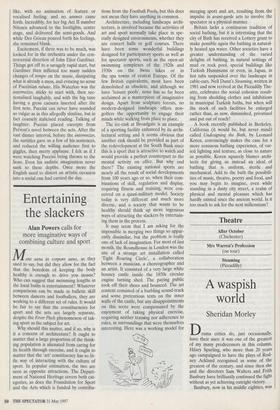Entertaining the slackers
Alan Powers calls for more imaginative ways of combining culture and sport
Mens sana in corpore sano, as they used to say, but did they allow for the fact that the boredom of keeping the body healthy is enough to drive you insane? Who can suggest that swimming lengths in the local baths is entertainment? Whatever comparisons can be made in balletic skill between dancers and footballers, they are working to a different set of rules. It would be fair to say that the constituencies for sport and the arts are largely separate, despite the Fever Pitch phenomenon of tak- ing sport as the subject for art.
Why should this matter, and if so, why is it a concern of architecture? It ought to matter that a large proportion of the think- ing population is alienated from caring for its health through exercise, and it ought to matter that the 'art' constituency has so lit- tle way of interacting with the culture of sport. In popular estimation, the two are seen as opposite attractions. The Depart- ment of National Heritage covers both cat- egories, as does the Foundation for Sport and the Arts which is funded by contribu- tions from the Football Pools, but this does not mean they have anything in common.
Architecture, including landscape archi- tecture, is involved because the activities of art and sport normally take place in spe- cially designed environments, whether they are concert halls or golf courses. There have been some wonderful buildings designed for participatory sports as well as for spectator sports, such as the open-air swimming complexes of the 1920s and 1930s on the Swiss lakes or in the spa towns of central Europe. Of the few British equivalents, most have been demolished as obsolete, and although we have 'leisure pools', none has so far been acclaimed as a masterpiece of imaginative design. Apart from sculpture forests, no modern-designed landscape offers non- golfers the opportunity to engage their minds while walking from place to place.
The ice-rink at Broadgate is an example of a sporting facility enhanced by its archi- tectural setting and it seems obvious that another rink should be provided as part of the redevelopment at the South Bank since this is a sport that is attractive to watch and would provide a perfect counterpart to the mental activity on offer. But why end there? The existing national sports are nearly all the result of social developments from 100 years ago or so, when their com- binations of skill, regulation and display, requiring fitness and training, were con- ceived on a quasi-military model. Society today is very different and much more diverse, and a society that wants to be healthy should think up more ingenious ways of attracting the slackers by entertain- ing them in the process.
It may seem that I am asking for the impossible in merging two things so appar- ently dissimilar, but the problem is really one of lack of imagination. For most of last month, the Roundhouse in London was the site of a strange art installation called `Tight Roaring Circle', a collaboration between a musician, a choreographer and an artist. It consisted of a very large white bouncy castle inside the 1850s circular engine turning shed. The paying public took off their shoes and bounced. The art content consisted of a burbling sound-track and some pretentious texts on the inner walls of the castle, but any disappointments on this score were compensated by the enjoyment of taking physical exercise, requiring neither training nor adherence to rules, in surroundings that were themselves interesting. Here was a working model for merging sport and art, resulting from the impulse in avant-garde arts to involve the spectator in a physical manner.
Britain lacks a continuous tradition of social bathing, but it is interesting that the city of Bath has received a Lottery grant to make possible again the bathing in natural- ly heated spa water. Other societies have a greater understanding of the varied delights of bathing, in natural settings of mud or rock pool, special buildings like Turkish Hummums or even, in Japan, in hot tubs suspended over the landscape in cable-cars. Nell Dunn's Steaming, written in 1981 and now revived at the Piccadilly The- atre, celebrates the social cohesion result- ing from shedding clothes and inhibitions in municipal Turkish baths, but when will the stock of such facilities be enlarged rather than, as now, diminished, privatised and put out of reach?
A book recently published in Berkeley, California (it would be, but never mind) called Undesigning the Bath, by Leonard Koren, convincingly makes the case for a more sensuous bathing experience, of var- ied lighting and texture, as close to nature as possible. Koren squarely blames archi- tects for giving us instead an ideal of bathing that is uniform, sterile and mechanical. Add to the bath the possibili- ties of music, theatre, poetry and food, and you may begin to imagine, even while standing in a dusty city street, a realm of physical and mental pleasure which has hardly existed since the ancient world. Is it too much to ask for the next millennium?


































































 Previous page
Previous page